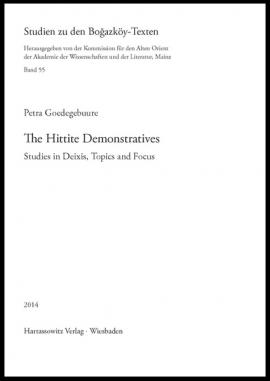Petra Goedegebuure, Associate Professor of Hittitology, has written a new book The Hittite Demonstratives: Studies in Deixis, Topics and Focus, Studien zu den Boğazköy-Texten 55 (Wisebaden: Harrassowitz Verlag, 2014). The summary of the volume can be found on the publisher's website: "In order to mitigate the lack of context inherent to the study of dead languages, the author has developed a descriptive model that combines (a) cognitive approaches to reference, (b) a theory of information structure, and (c) typological studies on demonstratives. With the help of this model the author not only provides for the first time a thorough description of the long-known demonstratives kā- “this” and apā- “that”, but also identifies a third demonstrative, asi “that, yonder”. This identification has led to a reappraisal of the distal semantics of apā-: apā- does not mark remote objects at all but points at objects in the vicinity of the addressee. In short, the Hittite demonstratives are not distance- but person-based. As a third person pronoun, apā- also expresses emphasis. A detailed analysis within the framework of information structure shows, for example, that apā- in preverbal position marks a referent as the Contrastive Focus of its clause (in “the dog (not the cat) chased the horse”, dog is in Contrastive Focus). Non-contrastive focal apā-, on the other hand, always occurs in initial position. The addition of information structure to the grammatical description of Hittite thus provides a better understanding of the meaning effects of word order variation in this SOV language."


